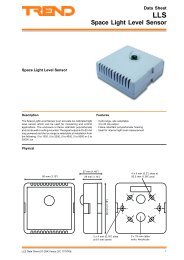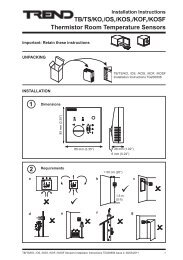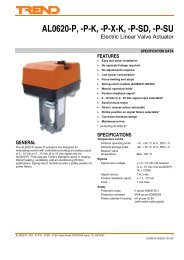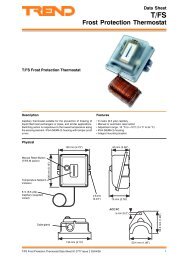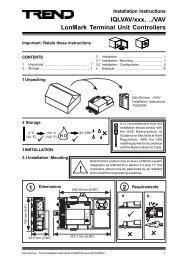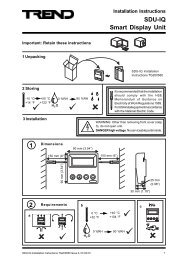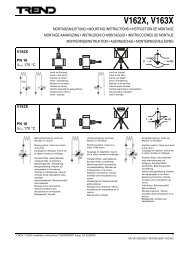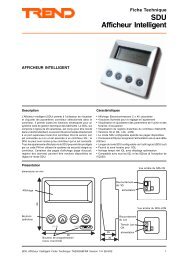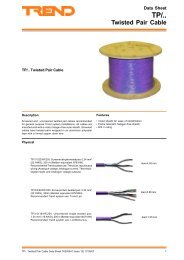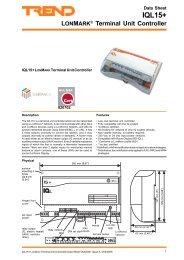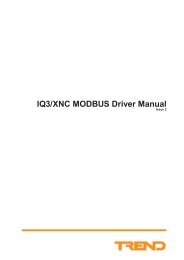TW/.., PCW/.., XW/R/IQ Wireless Sensors and Receiver Data ... - Trend
TW/.., PCW/.., XW/R/IQ Wireless Sensors and Receiver Data ... - Trend
TW/.., PCW/.., XW/R/IQ Wireless Sensors and Receiver Data ... - Trend
You also want an ePaper? Increase the reach of your titles
YUMPU automatically turns print PDFs into web optimized ePapers that Google loves.
100-240 V<br />
OK<br />
RX<br />
<strong>TW</strong>/.., <strong>PCW</strong>/.., <strong>XW</strong>/R/<strong>IQ</strong><br />
<strong>Data</strong> Sheet<br />
Physical (continued)<br />
ACCW/CONFIGKIT cable<br />
(kit also includes CD containing configuration software)<br />
ACCW/FK/SS<br />
3 m, 3 yds 1’<br />
9 Way D type<br />
Female (PC)<br />
2 screw terminals<br />
(<strong>IQ</strong> 24 V AUX output<br />
supply)<br />
stainless steel bracket<br />
(accessory for <strong>XW</strong>/R/<strong>IQ</strong>, <strong>PCW</strong>/..)<br />
3 m, 3 yds 1’<br />
RJ11 socket (<strong>XW</strong>/R/<strong>IQ</strong>)<br />
ACCW/RW/<strong>IQ</strong> (wireless sensor repeater)<br />
antenna<br />
13 A plug<br />
(supplied)<br />
230 Vac<br />
supply<br />
6 mm, 0.24”<br />
80 mm, 3.15”<br />
315 mm, 12.4”<br />
158 mm, 6.22”<br />
2 holes Ø 9 mm<br />
190 mm, 7.48”<br />
2 m, 2 yds<br />
180 mm, 7.09”<br />
60 mm, 2.36”<br />
FUNCTIONALITY<br />
The <strong>TW</strong>/.., <strong>PCW</strong>/.., <strong>XW</strong>/R/<strong>IQ</strong> wireless system consists of up to 32 wireless sensors (consisting of a mix of <strong>TW</strong>/.. <strong>and</strong> <strong>PCW</strong>/..)<br />
transmitting to an <strong>XW</strong>/R/<strong>IQ</strong> receiver. The <strong>XW</strong>/R/<strong>IQ</strong> receiver plugs into the local supervisor port of an <strong>IQ</strong>2 or <strong>IQ</strong>3 controller, <strong>and</strong> writes<br />
the sensors’ values <strong>and</strong> their status to defined analogue nodes <strong>and</strong> digital points within the <strong>IQ</strong> controller.<br />
Each wireless sensor is identified by a unique 3 byte (16,777,216 variants) number, which is printed on the sensor’s identification<br />
label. Using the ACCW/CONFIGKIT configuration software, the <strong>XW</strong>/R/<strong>IQ</strong> should be programmed to allocate each identification number<br />
to an analogue node within the local <strong>IQ</strong>, or within another <strong>IQ</strong> on the local Lan. The selected analogue node has associated digital<br />
points for reception of the sensor’s status<br />
<strong>PCW</strong>/..<br />
<strong>TW</strong>/S<br />
<strong>TW</strong>/P<br />
(installed in TB/TI)<br />
<strong>TW</strong>/P<br />
(installed in TB/TO)<br />
<strong>XW</strong>/R/<strong>IQ</strong><br />
up to 32 sensors<br />
RJ11<br />
<strong>Wireless</strong> <strong>Sensors</strong><br />
<strong>Wireless</strong> sensors measure the required parameters <strong>and</strong> transmit<br />
them regularly to the <strong>XW</strong>/R/<strong>IQ</strong> receiver.<br />
The sensor is powered by a lithium battery. If a low battery<br />
condition occurs, it will be indicated in the sensor’s digital status<br />
bits. The batteries are not field replaceable, <strong>and</strong> when the battery<br />
has run down (voltage



